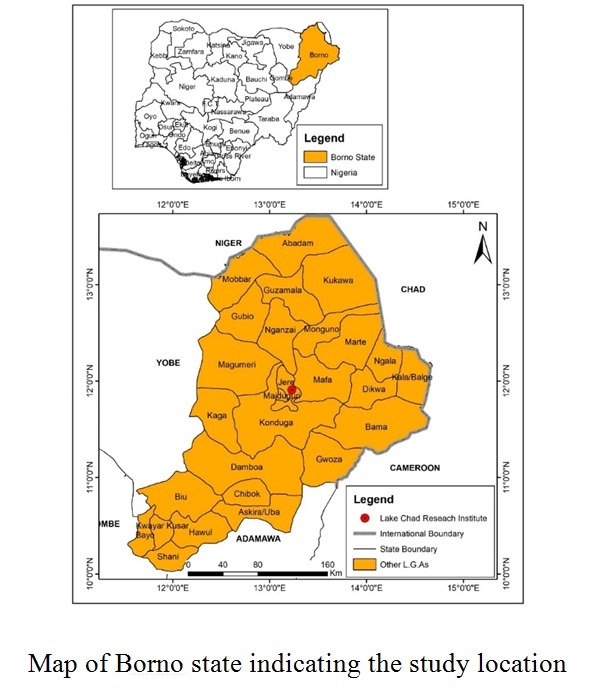Local sensitivity analysis of the AquaCrop model outputs for wheat under Semi-Arid water stress condition
DOI:
https://doi.org/10.57056/ajet.v8i1.83Keywords:
AquaCrop model, Lake Chad, Local sensitivity analysis, Semi-Arid, WheatAbstract
The FAO AquaCrop model has been extensively reported to simulate wheat growth and productivity in response to environmental conditions in many parts of the world. However, the calibration of the model could be tedious due to its large number of input parameters. The complexity in the model evaluation could be simplified by conducting a prior sensitivity analysis (SA), which information on it is hard to come-by in the North-eastern Nigeria. The SA of the model’s output variables to its input parameters was conducted using the local sensitivity analysis (LSA) technique. An early maturing REYNA-28 wheat variety was used under water deficit conditions in the semi-arid North-eastern Nigeria. The analysis revealed that the simulation of grain yield was highly influenced by days-to-flowering (DtF), normalized water productivity (WP*), reference harvest index (HIo), crop coefficient when the canopy is complete but prior to senescence (KcTrx) and maximum effective rooting depth (Zx) with sensitivity coefficients (SCs) of 1.23, 1.05, 0.83, 0.75 and 0.61, respectively. Biomass yield was highly sensitive to days-to-emergence (DtE), WP*, KcTrx, number of plants per hectare (den), soil surface covered by individual seedlings at 90 % emergence (ccs) and initial canopy cover (cco). The sensitivity of canopy cover was more to its related parameters such as DtE, maximum canopy cover (CCx), days-to-maximum canopy cover (DtCCx), canopy growth coefficient (CGC), ccs, cco, den and days-to-start of senescence (DtSS). Stress parameters were found to be either insensitive or with negligible sensitivity except lower soil water depletion threshold for canopy expansion (Pexlw). The analysis also revealed that the model outputs were insensitive to half of the model’s input parameters. These parameters could be fixed within their ranges in order to simplify the model and ease its calibration. The influential/sensitive parameters on the other hand require higher consideration during data collection, fine-tuning and calibration. This work can be validated using different SA techniques and wheat variety and under different environmental condition.
References
Silvestro PC, Pignatti S, Yang H, Yang G, Pascucci S, Castaldi F, et al. Sensitivity analysis of the AquaCrop and SAFYE crop models for the assessment of water limited winter wheat yield in regional scale applications. PLoS One. 2017;12(11):1–30.
Mwiya RM, Zhang Z, Zheng C, Wang C. Comparison of approaches for irrigation scheduling using AquaCrop and NSGA-III models under climate uncertainty. Sustain. 2020;12(18).
Upreti D, Pignatti S, Pascucci S, Tolomio M, Li Z, Huang W, et al. A Comparison of moment-independent and variance-based global sensitivity analysis approaches for wheat yield estimation with the AquaCrop-OS model. Agronomy. 2020;10(4):1–29.
Vanuytrecht E, Raes D, Willems P. Global sensitivity analysis of yield output from the water productivity model. Environ Model Softw [Internet]. 2014;51:323–32. Available from: http://dx.doi.org/10.1016/j.envsoft.2013.10.017
Dibal JM, Bashir AU, Haruna MM, Abubakar NA. Sensitivities of some reference evapotranspiration models to the key climatic variables in Northeastern Nigeria. Arid Zo J Eng Technol Environ. 2021;17(1):91–102.
Jin X, Li Z, Nie C, Xu X, Feng H, Guo W, et al. Parameter sensitivity analysis of the AquaCrop model based on extended fourier amplitude sensitivity under different agro-meteorological conditions and application. F Crop Res [Internet]. 2018;226(July):1–15. Available from: https://doi.org/10.1016/j.fcr.2018.07.002
Adabi V, Azizian A, Ramezani Etedali H, Kaviani A, Ababaei B. Local sensitivity analysis of AquaCrop model for wheat and maize in Qazvin Plain and Moghan Pars-Abad in Iran. Iran J Irrig Drain. 2020;13(6):1565–79.
Jalil A, Akhtar F, Awan UK. Evaluation of the AquaCrop model for winter wheat under different irrigation optimization strategies at the downstream Kabul River Basin of Afghanistan. Agric Water Manag [Internet]. 2020;240(2020):106321. Available from: https://doi.org/10.1016/j.agwat.2020.106321
Raes D, Steduto P, Hsiao TC, Fereres E. Chapter 1: crop-water productivity model to simulate yield response to water. In: Reference Manual: AquaCrop, Version 60 - 61 [Internet]. 2018. p. 23. Available from: www.fao.org/publications
Xing H min, Xu X gang, Li Z hai, Chen Y jin, Feng H kuan, Yang G jun, et al. Global sensitivity analysis of the AquaCrop model for winter wheat under different water treatments based on the extended Fourier amplitude sensitivity test. J Integr Agric. 2017;16(11):2444–58.
Guo D, Zhao R, Xing X, Ma X. Global sensitivity and uncertainty analysis of the AquaCrop model for maize under different irrigation and fertilizer management conditions. Arch Agron Soil Sci. 2020;66(8):1115–33.
Salemi H, Soom MAM, Lee TS, Mousavi SF, Ganji A, Yusoff MK. Application of AquaCrop model in deficit irrigation management of Winter wheat in arid region. African J Agric Res. 2011;6(10):2204–15.
Geerts S, Raes D, Garcia M, Miranda R, Cusicanqui JA, Taboada C, et al. Simulating yield response of quinoa to water availability with AquaCrop. Agron J. 2009;101(3):499–508.
Adeniji FA, Umara BG, Dibal JM, Amali AA. Variation of infiltration rates with soil texture. A laboratory study. Int J Eng Innov Technol. 2013;3(2):454–9.
Haruna MM, Ismail H, Bashir AU, Sani M. Effect of deficit irrigation on the performance of wheat (Triticum Aestivum l.) in a semi-arid region of North-Eastern Nigeria. In: Proceedings of the 22nd International Conference and 42nd Annual General Meetings of the Nigerian Institution of Agricultural Engineers. Asaba; 2022. p. 112–27.
Doorenbos J, Kassam AH. Yield response to water. Irrig Drain Pap. 1979;(33):257.
Lievens E. Parameterization and testing of the FAO AquaCrop model to simulate yield response to water in North-eastern Thailand. Dissertação (Mestrado em Engenharia de Biociências): Ciência Agrícola; 2014.
Vanuytrecht E, Raes D, Steduto P, Hsiao TC, Fereres E, Heng LK, et al. AquaCrop: FAO’s crop water productivity and yield response model. Environ Model Softw [Internet]. 2014;62:351–60. Available from: http://dx.doi.org/10.1016/j.envsoft.2014.08.005

Downloads
Published
How to Cite
Issue
Section
License
Copyright (c) 2024 Muhammad Mansur Haruna, Habibu Ismail, Ali Umar Bashir, Jibril Musa Dibal

This work is licensed under a Creative Commons Attribution-NonCommercial 4.0 International License.





